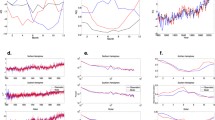Abstract
We use a seasonal energy balance climate model to study the behavior of the snowline cycle as a function of external parameters such as the solar constant. Our studies are confined in this study to cases with zonally symmetric land-sea distributions (bands or caps of land). The model is nonlinear in that the seasonally varying snow/sea ice line modifies the energy receipt through its different albedo from open land or water. The repeating steady-state seasonal cycle of the model is solved by a truncated Fourier series in time. This method is several thousand times faster than a time stepping approach. The results are interesting in that a number of bifurcations in the snowline behavior are found and studied for various geographies. Polar land caps and land bands positioned near the poles exhibit a variety of discontinuous summer snow cover behaviors (abrupt transitions as a parameter such as solar constant is slowly varied), which may be relevant to the inception and decay of continental ice sheets.
Similar content being viewed by others
References
Berger WH, Labeyrie LD (eds) (1987) Abrupt climate change. Reidel, Dordrecht
Broecker WS, Peteet DM, Rind D (1985) Does the ocean-atmosphere system have more than one stable mode of operation? Nature 315: 21–26
Burden RL, Faires JD (1985) Numerical analysis, 3rd edn. Prindle, Weber & Schmidt, Boston, pp 496–505
Budyko MI (1969) The effect of solar radiation variations on the climate of the Earth. Tellus 21: 611–619
Cahalan RF, North GR (1979) A stability theorem for energy balance climate models. J Atmos Sci 36: 1205–1216
Crowley TJ (1983) The geologic record of climate change. Rev Geophys Space Phys 1: 828–877
Crowley TJ, North GR (1988) Abrupt climate change and extinction events in Earth history. Science 240: 996–1002
Crowley TJ, Short DA, Mengel JG, North GR (1986) Role of seasonality in the evolution of climate over the past 100 million years. Science 231: 579–584
Crowley TJ, Mengel JG, Short DA (1987) Gondwanaland's seasonal cycle. Nature 329: 803–807
Drazin PG, Griffel DH (1977) On the branching structure of diffusive climatological models. J Atmos Sci 34: 1696–1706
Ghil M (1976) Climate stability for a Sellers-type model. J Atmos Sci 33: 3–20
Hyde WT, Crowley TJ, Kim KY, North GR (1989) Comparison of GCM and energy balance model simulations of seasonal temperature changes over the past 18 000 years. J Clim 2: 864–887
Iooss G, Joseph DD (1980) Elementary stability and bifurcation theory. Springer, New York Heidelberg Berlin, pp 126–133
Lin RQ (1988) A hierarchy of perturbative models for solving nonlinear problems in geophysical fluid dynamics: systematic use of symbolic manipulation. PhD thesis, UCLA
Mengel JG, Short DA, North GR (1988) Seasonal snowline instability in an energy balance model. Clim Dyn 2: 127–131
North GR (1975a) Analytical solution to a simple climate model with diffusive heat transport. J Atmos Sci 32: 1301–1307
North GR (1975b) Theory of energy-balance climate model. J Atmos Sci 32: 2033–2043
North GR (1984) The small ice cap instability in diffusive climate model. J Atmos Sci 41: 3390–3395
North GR, Coakley JA Jr (1979) Differences between seasonal and mean annual energy balance model calculations of climate and climate sensitivity. J Atmos Sci 36: 1189–1204
North GR, Crowley TJ (1985) Application of a seasonal climate model to Cenozoic glaciation. J Geol Soc Lond 142: 475–482
North GR, Mengel JG, Short DA (1983) Simple energy balance model resolving the seasons and the continents: application to the astronomical theory of the ice ages. J Geophys Res 88: 6576–6586
Ramanathan V, Cess RD, Harrison EF, Minnis P, Barkstrom BR, Ahmad E, Hartmann D (1989) Cloud-radiative forcing and climate: results from the Earth Radiation Budget Experiment. Science 243: 57–62
Savin SM (1977) The history of the Earth's surface temperature during the past 100 million years. Annu Rev Earth Planet Sci 5: 319–355
Sellers WD (1969) A climate model based on the energy balance of the earth-atmosphere system. J Clim Appl Meteorol 8: 392–400
Short DA, North GR, Bess TD, Smith GL (1984) Infrared parameterization and simple climate models. J Clim Appl Meteorol 23: 1222–1233
Suarez MJ, Held IM (1979) The sensitivity of an energy balance model to variations in orbital parameters. J Geophys Res 84: 4825–4836
Watts R, Hayder M (1984) The effect of land-sea distribution on ice sheet formation. Ann Glaciol 56: 234–236
Author information
Authors and Affiliations
Rights and permissions
About this article
Cite this article
Lin, R.Q., North, G.R. A study of abrupt climate change in a simple nonlinear climate model. Climate Dynamics 4, 253–261 (1990). https://doi.org/10.1007/BF00211062
Received:
Accepted:
Issue Date:
DOI: https://doi.org/10.1007/BF00211062




